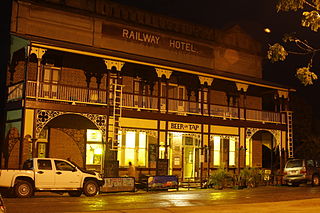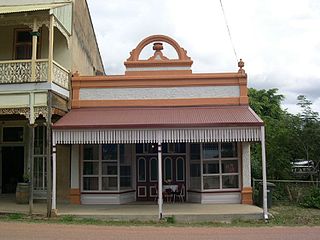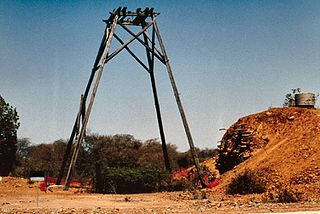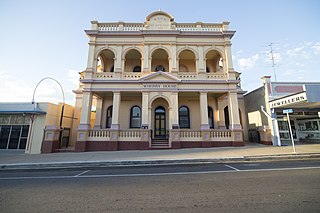
Ravenswood is a rural town and locality in the Charters Towers Region, Queensland, Australia. In the 2016 census, the locality of Ravenswood had a population of 255 people.

Ravenswood Ambulance Station is a heritage-listed ambulance station at Deighton Street, Ravenswood, Charters Towers Region, Queensland, Australia. It was built in 1904. It was added to the Queensland Heritage Register on 21 October 1992.

Gympie Ambulance Station is a heritage-listed ambulance station at 17 Crown Road, Gympie, Queensland, Australia. It was built in 1904. It was added to the Queensland Heritage Register on 16 September 2011.

West End Hotel is a heritage-listed hotel at 89 Ingham Road, West End, City of Townsville, Queensland, Australia. It was built in 1885 by Peter Dean. It was added to the Queensland Heritage Register on 24 June 1999.

Railway Hotel is a heritage-listed hotel at Barton Street, Ravenswood, Charters Towers Region, Queensland, Australia. It was built c. 1901. It was added to the Queensland Heritage Register on 21 October 1992.

Imperial Hotel is a heritage-listed hotel at Macrossan Street, Ravenswood, Charters Towers Region, Queensland, Australia. It was designed by Eaton, Bates & Polin and built in 1901. It was added to the Queensland Heritage Register on 21 October 1992.

Cake Shop is a heritage-listed shop at Macrossan Street, Ravenswood, Charters Towers Region, Queensland, Australia. It was built in the 1880s. It is also known as Jun Yeung Wong & Company and The Pie Shop. It was added to the Queensland Heritage Register on 21 October 1992.

Ravenswood School of Arts is a heritage-listed school of arts at Macrossan Street, Ravenswood, Charters Towers Region, Queensland, Australia. It was built in 1884. It was added to the Queensland Heritage Register on 21 October 1992.

Ravenswood School and Residence is a heritage-listed state school and house at School Street, Ravenswood, Charters Towers Region, Queensland, Australia. It was built from 1873 to 1897. It was added to the Queensland Heritage Register on 21 October 1992.

Thorps Building is a heritage-listed commercial building at Macrossan Street, Ravenswood, Charters Towers Region, Queensland, Australia. It was built c. 1903. It is also known as Burns & Fritz Hardware, Hollimans Limited, and Thorp's Goldfield Tearooms. It was added to the Queensland Heritage Register on 21 October 1992.

Shop adjacent to Thorps Building is a heritage-listed shop at Macrossan Street, Ravenswood, Charters Towers Region, Queensland, Australia. It was built c. 1901. It was added to the Queensland Heritage Register on 21 October 1992.

Ravenswood Court House and Police Station is a heritage-listed former courthouse and police station at Raven Street, Ravenswood, Charters Towers Region, Queensland, Australia. They were designed by the Queensland Department of Public Works and were built in 1882 by A Donald and FA Sparre. They are also known as Ravenswood Court House Group. They were added to the Queensland Heritage Register on 27 January 1994.

Mabel Mill is a heritage-listed former stamper battery at Barton Street, Ravenswood, Charters Towers Region, Queensland, Australia. It was built from c. 1871 to c. 1902. It is also known as Mabel Mill and Partridge Mill. It was added to the Queensland Heritage Register on 28 January 1994.

London North Mine is a heritage-listed mine at Elphinstone street, Ravenswood, Charters Towers Region, Queensland, Australia. It was built from c. 1903 to 1915. It was added to the Queensland Heritage Register on 22 February 1994.

Bank of New South Wales is a heritage-listed former bank building at 34–36 Gill Street, Charters Towers City, Charters Towers, Charters Towers Region, Queensland, Australia. It was designed by Eyre & Munro and built in 1889 by Kelleher. It is also known as Wherry House. It was added to the Queensland Heritage Register on 9 November 2012.

ED Miles Mining Exchange is a heritage-listed commercial building at 65 Mosman Street, Charters Towers City, Charters Towers, Charters Towers Region, Queensland, Australia. It was designed by William George Smith junior, and built in 1887 by Ben Toll. It was added to the Queensland Heritage Register on 9 November 2012.

Croydon Hospital Ward is a heritage-listed former hospital at Sircom Street, Croydon, Shire of Croydon, Queensland, Australia. It was built in 1894. It is also known as Croydon State Emergency Services Building. It was added to the Queensland Heritage Register on 21 October 1992.

Ravenswood Mining Landscape and Chinese Settlement Area is a heritage-listed former mining town and archaeological site on the reserve bounded by School Street, Cemetery Road, Railway Street and Burdekin Falls Dam Road, Ravenswood, Charters Towers Region, Queensland, Australia. It was added to the Queensland Heritage Register on 14 October 2016.

Queensland National Bank is a heritage-listed former bank building at 72 Mosman Street, Charters Towers City, Charters Towers, Charters Towers Region, Queensland, Australia. It was designed by Francis Drummond Greville Stanley and built from 1891 to 1949. It is also known as the Charters Towers' City Hall. It was added to the Queensland Heritage Register on 26 June 2020.

Chapel Street Bridge is a heritage-listed road bridge at Chapel Street, Ravenswood, Charters Towers Region, Queensland, Australia. It was built from 1895 to 1898. It was added to the Queensland Heritage Register on 29 November 2019.






















